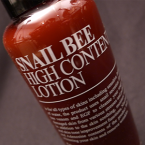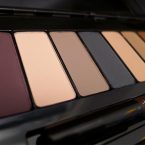Hanyul White Chrysanthemum Powder Serum Review
Affiliate Links I Bought This April 30, 2014 | Asian Skincare, Reviews, Serum, Skincare
With the exception of a couple of product-testing spots I got last week, I’ve been mostly acne free for about 4 months. FOUR MONTHS. How amazing is that? Unfortunately, I still have tons of red marks left behind from my old spots. Additionally, even though I haven’t been getting any full-on breakouts, I’ve had a several of what I am now calling “almost breakouts,” which consist of a small, closed comedones that disappear within a day, but still somehow manage to leave behind red marks as if they’d been real pimples. The upside to this phenomenon is that it’s giving me the opportunity to try a ton of PIH lightening products. The bottle of lightening product I’ve finished most recently is the new Hanyul White Chrysanthemum Powder Serum, and the subject of today’s review.
I’d like to preface this review by disclosing that I didn’t use this serum on it’s own – I’ve also been trying out a weekly AHA treatment by Paula’s Choice, which I’ll be covering in the next few days. However, I think the two worked nicely together – more details on that later.
What is it?
Hanyul White Chrysanthemum Powder Serum ($69) is a skin brightening and spot lightening serum. It promises to brighten and improve skin tone, as well as improve the appearance of blemishes, freckles, and dull skin.
Ingredients:
Cnidium Officinale Root (Cnidium) Extract, Angelica Acutiloba (Angelica) Root Extract, Butylene Glycol, Pentaerythrityl Tetraethylhexanoate, Phenyl Trimethicone, Propanediol, Dimethicone, Octyldodecyl Myristate, Hydroxypropyl Cyclodextrin, Kojic Acid, Chrysanthemum Extract (White Chrysanthemum 1,000ppm), Mushroom (Corthellus Shiitake) Extract, Peony Extract, Ginger Extract, Apricot Kernel Extract, Coix Seed Extract, Mulberry Leaf Extract, Lithospermum Erythrorhizon Root Extract, Safflower Seed Oil, Barley Extract, Rice Extract, Phaseolus Angularis Seed Extract, Soybean (Glycine Max) Seed Extract, Mung Bean Extract, Bacillus/Soybean Ferment Extract, Adenosine, Cyclopentasiloxane, C14-22 Alcohols, Inulin Lauryl Carbamate, Polymethylsilsesquioxane, Dimethiconol, Hydroxyethyl Acrylate/Sodium Acryloyldimethyl Taurate Copolymer, Cetearyl Alcohol, Caffeic Acid, C12-20 Alkyl Glucoside, Xanthan Gum, Carbomer, Glyceryl Stearate, Water, Stearic Acid, Disodium EDTA, Tromethamine, Hydrogenated Lecithin, Polyglyceryl-4 Methylglucose Distearate, Methoxy PEG-114/Polyepsilon Caprolactone, Mannitol, Trehalose, Polysorbate20, Phenoxyethanol, Fragrance. (*Beautiful Fair Trade Materials used: Angelica, Cnidium)
Here are the highlights I found in for this formula:
Cnidium Officinale Root (Cnidium) Extract
The primary thing I find interesting about this ingredient is that it’s the first ingredient in this serum. What can I say? I get excited when the first ingredient in any list is functional. Most of the scientific data I found concerning Cnidium Officinale revolved around its antioxidant and free-radical scavenging properties. I did see one very brief mention of its ability to lighten skin by inhibiting a hormone called a-MSH, which is a primary player in the pigmentation of skin.
Changing skin color: Evolution and modern trends
Indian Journal of Dermatology, 2007
Kojic Acid
Kojic acid is an antibacterial, antifungal substance derived from mushrooms. It is a proven skin-lightening agent, and functions similarly to hydroquinone in that it inhibits melanin production, but it’s less likely than hydroquinone to cause irritation.
White Chrysanthemum Extract
The primary reason I included Chrysanthemum in the highlights is to clear up some misconception about its presence in this formula. The marketing for this serum touts White Chrysanthemum Extract as the star whitening agent for this formula. However, there is almost no connection between Chrysanthemums and skin lightening – the closest thing I could find was a study that very indirectly links the two, and indicates that the smell of Chrysanthemum extract indices better sleep, which, in turn, makes skin appear lighter. I find this science shaky at best, and I think it’s very strange that the marketing for this product is so misleading, when there are clearly plenty of other proven skin lightening ingredients in this formula.
Chrysanthemum extract isn’t totally pointless though – it has plenty of value as an anti-inflammatory, astringent, and anti-irritant ingredient. It also possesses antioxidant and antimicrobial properties.
Sleep Quality & Skin Lightening Effects of White Mother Chrysanthemum Aroma, 2014
Industrial Applications of Affective Engineering
Anti-inflammatory activity of Chrysanthemum indicum extract in acute and chronic cutaneous inflammation. 2009
Journal of Ethnopharmacology
Peony Extract
For the most part, the value of peony extract is that it has such potent antioxidant properties. I did run across one study that indicated it could lighten skin discoloration caused by UVB damage, but the study was conducted on a skin model, and not actual skin.
Mulberry Leaf Extract
Mulberry Leaf Extract is popular in skin lightening formulas because of its Arbutin content. It also contains Vitamin A.

Kojic acid is pH sensitive. It performs best at a pH between 4 and 9, which is a pretty generous range. The pH for this formula appears to be right around 5.
According to CosDNA, the only major red flag as far as potential acne triggers or irritants go is Cetearyl Alcohol, which ranks a 4 out 5 as a potential acne trigger, and a 3 out of 5 as a potential irritant.
Performance
Appearance
Straight out of the box, the bottle for the Hanyul White Chrysanthemum Powder Serum has a temporary cap on top, which contains some sort of powdered ingredient. There are instructions included, but it was fairly easy to figure out what needed to happen next on my own: the button on top of the cap needed to be pressed, which breaks the seal separating the powder from the rest of the serum. Here’s where I screwed up though: the contents of the bottle need to be shaken, and instead of waiting until I’d screwed in the actual pump, I shook it while the temporary cap was still on. I realized what a mistake this was when I removed the cap and saw how much product was stuck inside of it. I tried to salvage it, but the damage was done. I probably wasted 3 or 4 applications by not waiting until the final pump was attached to shake it. It’s worth noting that once the powder is mixed into the serum, this product only has a shelf life of about 3 months.
The finished bottle is a beautiful little thing. It’s an iridescent white, with the product name written in English on one side, and in Korean on the other. The dispensing mechanism is a sleek little pump.
The product itself is bright white, and thin but not watery.
Smell
Hanyul White Chrysanthemum Powder Serum smells amazing. My first thought when I applied it was, “Wait, is this really what Chrysanthemums smell like? Why aren’t we all wearing Chrysanthemum perfume?” Note: I’m going to find a Chrysanthemum perfume, or at the very least, a body lotion.
Application
I applied Hanyul White Chrysanthemum Powder Serum morning and evening, spreading it over my face after my toning step. In retrospect, I probably could have just used this serum once a day. Additionally, I think I was using too much – I wasn’t sure how much I needed, so I’d dispense about 3 or 4 pumps because without having any frame of reference, that’s what looked like the right amount to me. In reality, I think 2 pumps would have sufficed. None of this over usage did any damage to my skin at all, but I did run out of serum in less than a month, and then I was sad. If I’d used it once a day and only used a couple of pumps, I think I would have gotten at least a couple of months out of it.
Once applied, the serum absorbs quickly and does not feel sticky, heavy, or greasy. That heavenly Chrysanthemum smell does linger for a few minutes, but I would have been happy if it had followed me for hours.
Results
I used the White Chrysanthemum Powder Serum for just 2 days shy of a month. At no point did I experience any irritation or breakouts as a result of using this product. As previously mentioned, I did use this in conjunction with a weekly AHA treatment by Paula’s Choice, which I started using a couple of weeks after I started the Chrysanthemum Serum. I used the AHA treatment twice over those two weeks.
The stubborn PIH marks shown in the before & after photo below are from my last full-on breakout, which was just over 4 months ago.
I definitely noticed my PIH marks lightening over the month that I used this, but it wasn’t until I looked at the before and after photos that I realized how dramatic they were. Additionally, my overall skin tone definitely appeared brighter at the end of the testing period.
Overall, I’m extremely pleased with this serum. It did exactly what it promised to do, even if its Chrysanthemum marketing hype was a little misguided. It’s a pricier product, but it got me results and it was really a joy to use. I would purchase this serum again, but next time, I’ll try to go easy on the usage and try to make it last as long as it was intended.
Pros:
– Brightens skin tone
– Lightens PIH
– Smells spectacular
– Light, non-greasy
Cons:
– None
Skin & Tonics Rating
Efficacy: 20/20
Ingredients: 15/20
Application: 20/20
Wear: 20/20
Packaging: 20/20
Overall: A (95/100)
Where to Buy
I bought my Hanyul White Chrysanthemum Powder Serum at W2Beauty, where it retails for $69. First time W2Beauty customers can get a $5 W2Beauty voucher by entering my sponsor code at sign-up: 025605.
It’s also available from eBay seller 2bestyle for $68.
This post contains affiliate links. Shopping these links helps support this site. Full disclosure »

























Hmmmm. I’m a bit skeptical, as I tend to be about lightening products. How much of this product’s effectiveness was the actual product, and how much was the fact that your skin heals on its own? A whole month is a long time, and my own PIH tends to go away significantly after about three weeks, excepting a few stubborn spots.
Wow, your PIH heals in a month on its own? I’m jealous! Without assistance, mine lingers for months.
It might be because I am mixed African-American and white, so my skin is slightly darker and the spots seem to fade more quickly. xD But that makes more sense as to why you said it was this product that faded it.
I think i am very jealous too! i have marks from over 1/2 year ago that is just finally lightening…I started with Mizon’s snail cream about a month ago and found that’s been helping slightly
Oh nice, I’m glad something’s working for you! I feel your pain – 6 to 9 months is not an usual amount of time for my PIH to linger if I don’t use any lightening products.
Those “almost breakouts” are such a pain in the butt! They take longer to go away too, am I right? Am in need of lightning products that don’t burn a hole in my wallet. Nice reading this review though!
They really are a drag. Most of my “almost breakout” red marks stick around at least as long as the marks from an actual breakout. If you’re looking for a spot lightening product that’s more affordable, you might be interested in the Paula’s Choice AHA treatment I’m reviewing later this week! That one is very reasonably priced. 🙂
Oooh nice (though the price of it makes me cringe)! Do you plan to continue using this serum? Don’t serums also reach a point where they aren’t as effective?
Hey Becky! If I was a regular person I would probably buy it again. But since my hobby is trying reviewing skin care products, I rarely buy the same product continuously. I have a few other whitening serums lined up to try now: Su:m37 Whitening Ampoule, It’s Skin Power 10 WH Effector Serum, and Circle Red Spot Serum.
Regarding serums not working after a period of time – it’s true to an extent, but has more to do with our skin’s peak state than it does with the serums themselves. With any skin care ingredient, there does come a point of diminishing returns. By that, I mean that there is a limit for how good certain qualities of our skin can get. For example, my skin has an optimum level of brightness that once reached, I cannot surpass. If I could, my face would be a heavenly ray of white light by now! The ceiling for these qualities is obviously different for everyone.
The most any skin care active could hope to achieve is to bring our skin to our personal best, and from there on out, we’re working to maintain that state. If there is an ingredient that helps my skin get to a particular desired state, that ingredient won’t stop working, but my skin will reach a barrier when it reaches its peak state.
Oh wow, that is quite a number of products! I can’t wait to hear about them all (and possibly give my bank account more reasons to cry…haaaa). Thank you for the super helpful information regarding products and their effectiveness! Yayzers for learning new things! 🙂 If only it was that easy to achieve a face that seems to have a heavenly ray of white light…..
Hmm, would you recommend trying this or just restock the ost vit c serum instead?
Also, I love the addition of the pH levels being listed in your review as well! I’ve read that it’s pretty important to find out pH levels in skincare products in general (like if your cleanser is too high a level, then a BHA toner wouldn’t work as effectively because it’s the step directly after. It sounds logical, but I don’t know how valid it is, lol)?
Hey Belinda! I think both serums are great. OST Vitamin C Serum is a better value, but this Hanyul serum seems like it would be much better for sensitive skin (if that’s a concern).
Interesting! I haven’t heard of cleansers pH level affecting a toner that’s applied afterward – I don’t think that’s the case. But I definitely like to steer clear of cleansers with a high pH – alkaline cleansers damage the skin’s protective acid mantle / moisture barrier, and make us more susceptible to water loss, inflammation, irritation, bacteria, and acne. pH levels are also really important indicators for the efficacy of skin care actives. 🙂
Nooooooo the voucher code doesn’t work! 🙁
Hi Chelle! Are you entering the code at signup or at checkout? The code only works at signup. 🙂
Hi Kerry,
I was wondering out of this serum and the Missha Time Revolution Revolution Night Repair Science Activator Ampoule, which would you prefer? I am in the market for a new serum and i’m reading pretty good reviews on both so far. Thank you!
Hi Melissa! I think it depends on what you’re hoping to achieve with your skin. If you’re looking for age prevention and a little extra moisture, I’d go with the Missha Time Revolution Night Repair. If you’re concerns are more about brightness and/or uneven tone, I would go with with Hanyul serum! 🙂
Wow! You’re amazing! Thank you for replying to both of my comments right away! I’m in my mid twenties so I figured I should probably start looking into age prevention. I purchased the Time Revolution Night Repair yesterday (Came with a free full size Night Repair Master Cream, White Cure 4 piece travel set, and a green tea masque… how could i resist??). But at the same time I also have uneven skin tone (redness on cheeks and a little on my jawline) and would like my skin to be brighter. I think I might purchase the Hanyul serum to use during the day and use the Time Revolution Night Repair at night. Or maybe use the OST Vitamin C during the day and the hanyul and time revolution night repair at night. Decisions decisions! *First world problems* hahha.. Anyways, thank your for your advice! Hopefully my skin will be as porcelain smooth and bright and yours one day! 🙂
*AS yours one day. Whoops! Typo!
Kerry, great post indeed.
Hi Melissa from where did you buy your Missha to get sooo many freebies along with a full-size? Wow!!